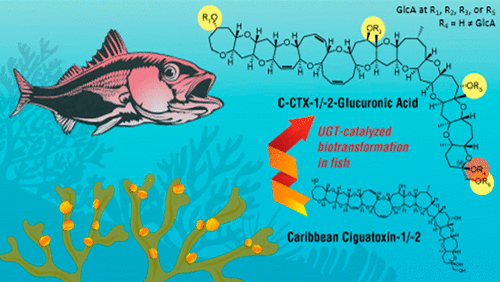当前位置:
X-MOL 学术
›
Chem. Res. Toxicol.
›
论文详情
Our official English website, www.x-mol.net, welcomes your
feedback! (Note: you will need to create a separate account there.)
In Vitro Glucuronidation of Caribbean Ciguatoxins in Fish: First Report of Conjugative Ciguatoxin Metabolites
Chemical Research in Toxicology ( IF 3.7 ) Pub Date : 2021-07-28 , DOI: 10.1021/acs.chemrestox.1c00181 Jessica Kay Gwinn 1, 2 , Silvio Uhlig 3 , Lada Ivanova 3 , Christiane Kruse Fæste 3 , Fedor Kryuchkov 3 , Alison Robertson 1, 2
Chemical Research in Toxicology ( IF 3.7 ) Pub Date : 2021-07-28 , DOI: 10.1021/acs.chemrestox.1c00181 Jessica Kay Gwinn 1, 2 , Silvio Uhlig 3 , Lada Ivanova 3 , Christiane Kruse Fæste 3 , Fedor Kryuchkov 3 , Alison Robertson 1, 2
Affiliation

|
Ciguatoxins (CTX) are potent marine neurotoxins, which can bioaccumulate in seafood, causing a severe and prevalent human illness known as ciguatera poisoning (CP). Despite the worldwide impact of ciguatera, effective disease management is hindered by a lack of knowledge regarding the movement and biotransformation of CTX congeners in marine food webs, particularly in the Caribbean and Western Atlantic. In this study we investigated the hepatic biotransformation of C-CTX across several fish and mammalian species through a series of in vitro metabolism assays focused on phase I (CYP P450; functionalization) and phase II (UGT; conjugation) reactions. Using liquid chromatography high-resolution mass spectrometry to explore potential C-CTX metabolites, we observed two glucuronide products of C-CTX-1/-2 and provided additional evidence from high-resolution tandem mass spectrometry to support their identification. Chemical reduction experiments confirmed that the metabolites were comprised of four distinct glucuronide products with the sugar attached at two separate sites on C-CTX-1/-2 and excluded the C-56 hydroxyl group as the conjugation site. Glucuronidation is a novel biotransformation pathway not yet reported for CTX or other related polyether phycotoxins, yet its occurrence across all fish species tested suggests that it could be a prevalent and important detoxification mechanism in marine organisms. The absence of glucuronidation observed in this study for both rat and human microsomes suggests that alternate biotransformation pathways may be dominant in higher vertebrates.
中文翻译:

鱼类中加勒比雪卡毒素的体外葡萄糖醛酸化:结合型雪卡毒素代谢物的首次报告
雪卡毒素 (CTX) 是强效海洋神经毒素,可在海鲜中生物蓄积,导致严重且普遍的人类疾病,称为雪卡中毒 (CP)。尽管雪卡在全球范围内产生影响,但由于缺乏对 CTX 同系物在海洋食物网中的运动和生物转化的了解,有效的疾病管理受到阻碍,特别是在加勒比海和西大西洋。在这项研究中,我们通过一系列侧重于 I 相(CYP P450;功能化)和 II 相(UGT;缀合)反应的体外代谢测定,研究了 C-CTX 在几种鱼类和哺乳动物物种中的肝脏生物转化。使用液相色谱高分辨率质谱法探索潜在的 C-CTX 代谢物,我们观察到了 C-CTX-1/-2 的两种葡萄糖苷酸产物,并提供了来自高分辨率串联质谱法的额外证据来支持它们的鉴定。化学还原实验证实,代谢物由四种不同的葡萄糖醛酸产物组成,糖附着在 C-CTX-1/-2 上的两个不同位点上,并排除 C-56 羟基作为缀合位点。葡萄糖醛酸化是 CTX 或其他相关聚醚藻毒素的一种新型生物转化途径,尚未有报道,但它在所有测试的鱼类中的存在表明它可能是海洋生物中普遍且重要的解毒机制。本研究中观察到大鼠和人类微粒体均不存在葡萄糖醛酸化,这表明替代生物转化途径可能在高等脊椎动物中占主导地位。
更新日期:2021-08-16
中文翻译:

鱼类中加勒比雪卡毒素的体外葡萄糖醛酸化:结合型雪卡毒素代谢物的首次报告
雪卡毒素 (CTX) 是强效海洋神经毒素,可在海鲜中生物蓄积,导致严重且普遍的人类疾病,称为雪卡中毒 (CP)。尽管雪卡在全球范围内产生影响,但由于缺乏对 CTX 同系物在海洋食物网中的运动和生物转化的了解,有效的疾病管理受到阻碍,特别是在加勒比海和西大西洋。在这项研究中,我们通过一系列侧重于 I 相(CYP P450;功能化)和 II 相(UGT;缀合)反应的体外代谢测定,研究了 C-CTX 在几种鱼类和哺乳动物物种中的肝脏生物转化。使用液相色谱高分辨率质谱法探索潜在的 C-CTX 代谢物,我们观察到了 C-CTX-1/-2 的两种葡萄糖苷酸产物,并提供了来自高分辨率串联质谱法的额外证据来支持它们的鉴定。化学还原实验证实,代谢物由四种不同的葡萄糖醛酸产物组成,糖附着在 C-CTX-1/-2 上的两个不同位点上,并排除 C-56 羟基作为缀合位点。葡萄糖醛酸化是 CTX 或其他相关聚醚藻毒素的一种新型生物转化途径,尚未有报道,但它在所有测试的鱼类中的存在表明它可能是海洋生物中普遍且重要的解毒机制。本研究中观察到大鼠和人类微粒体均不存在葡萄糖醛酸化,这表明替代生物转化途径可能在高等脊椎动物中占主导地位。






























 京公网安备 11010802027423号
京公网安备 11010802027423号